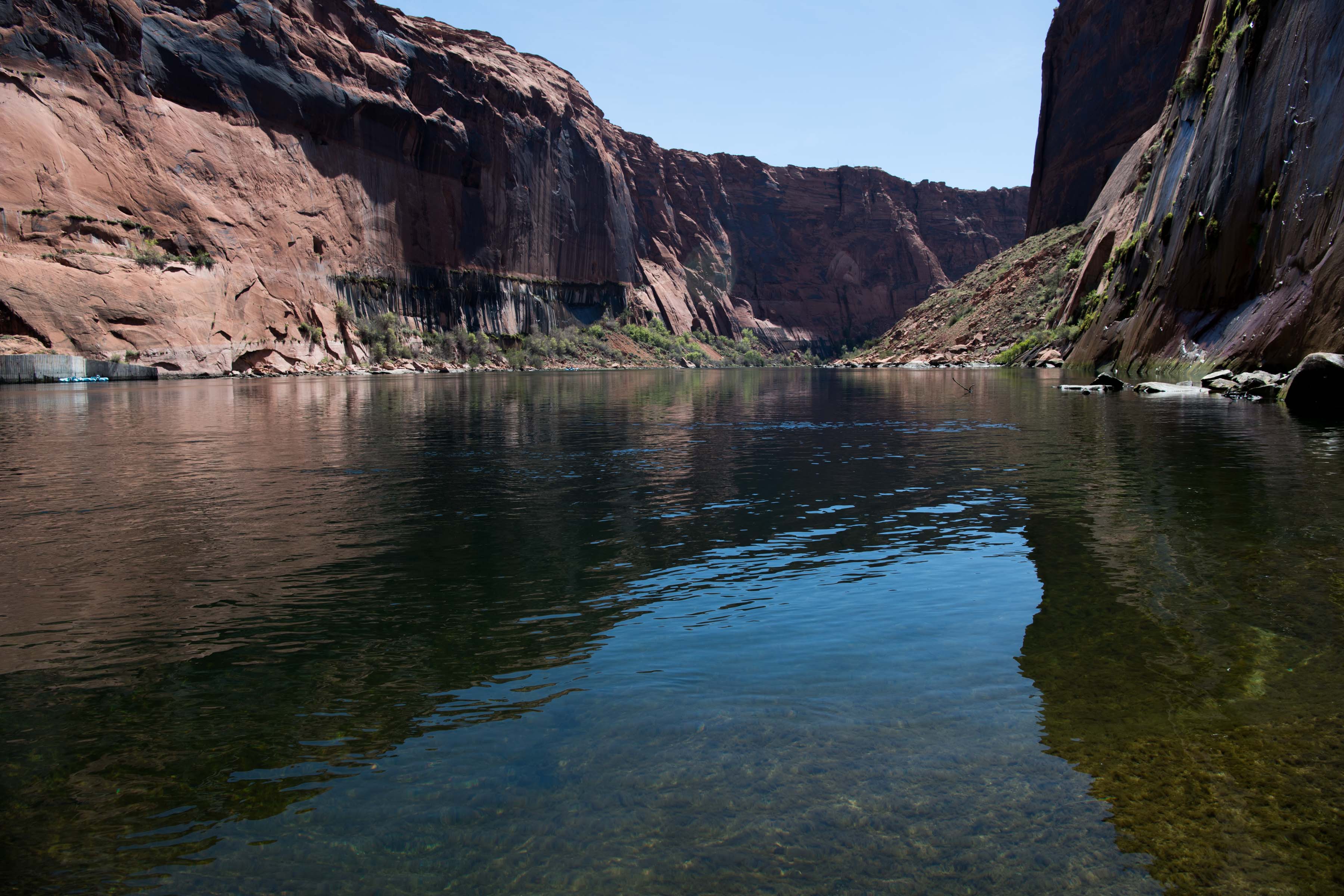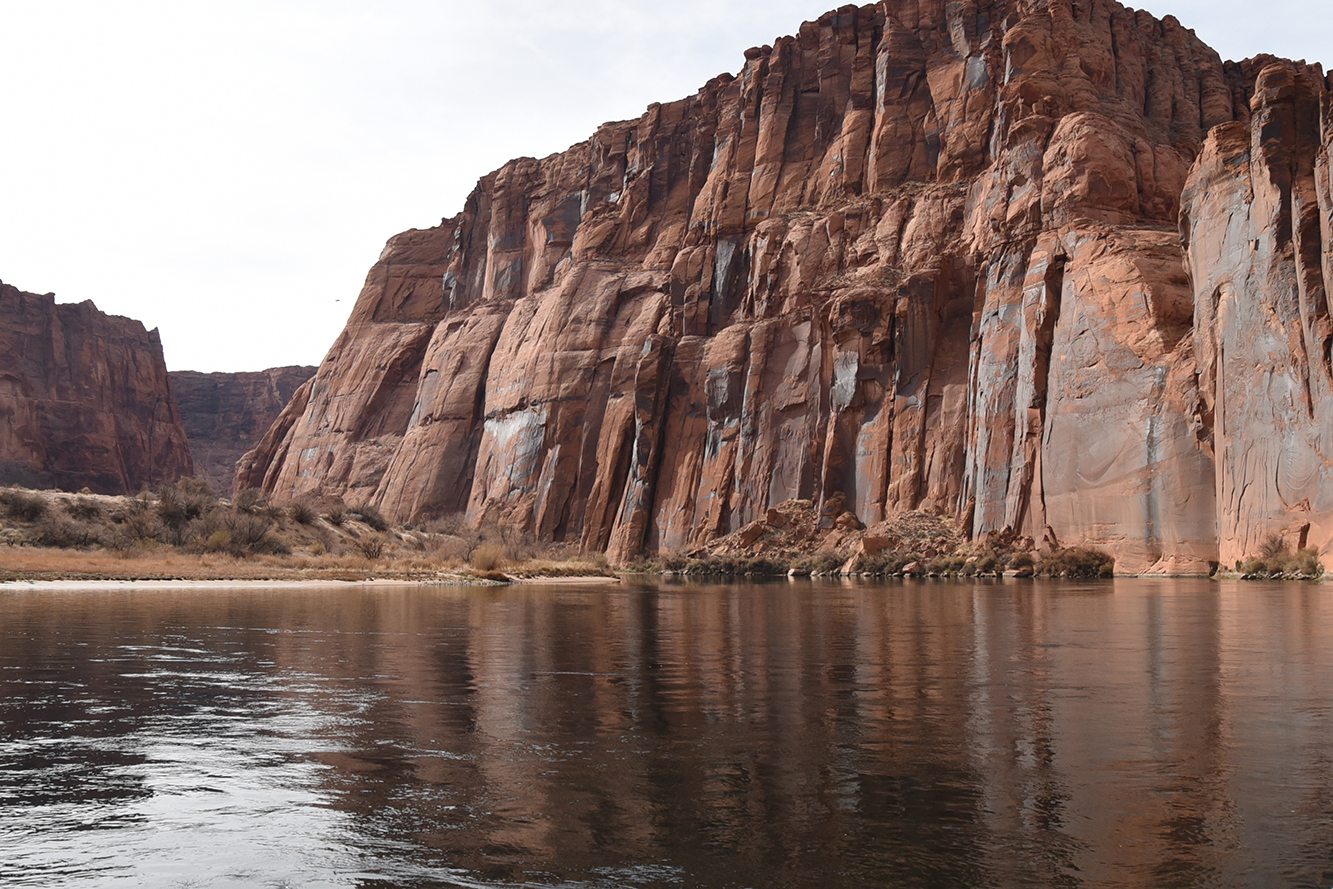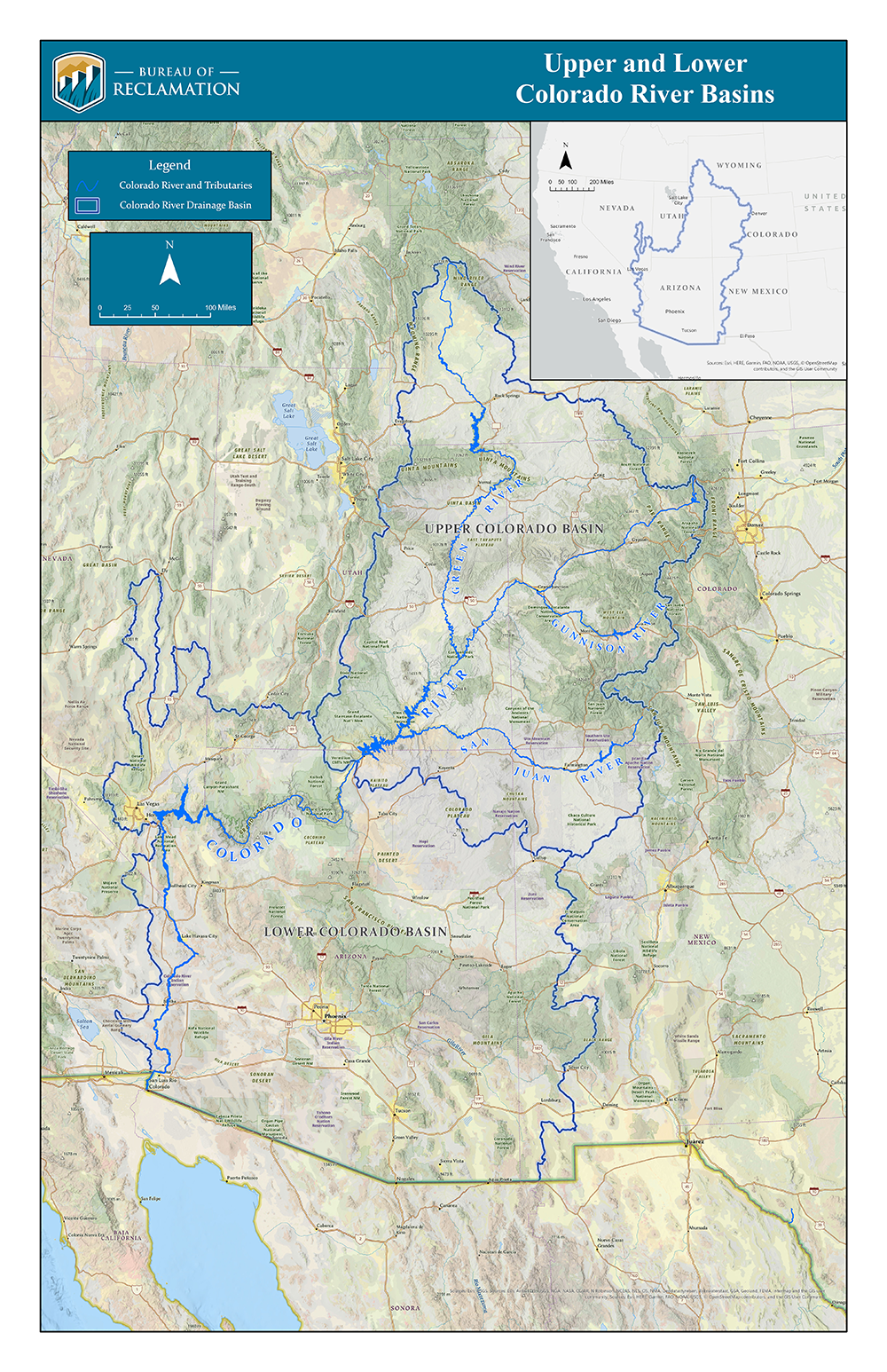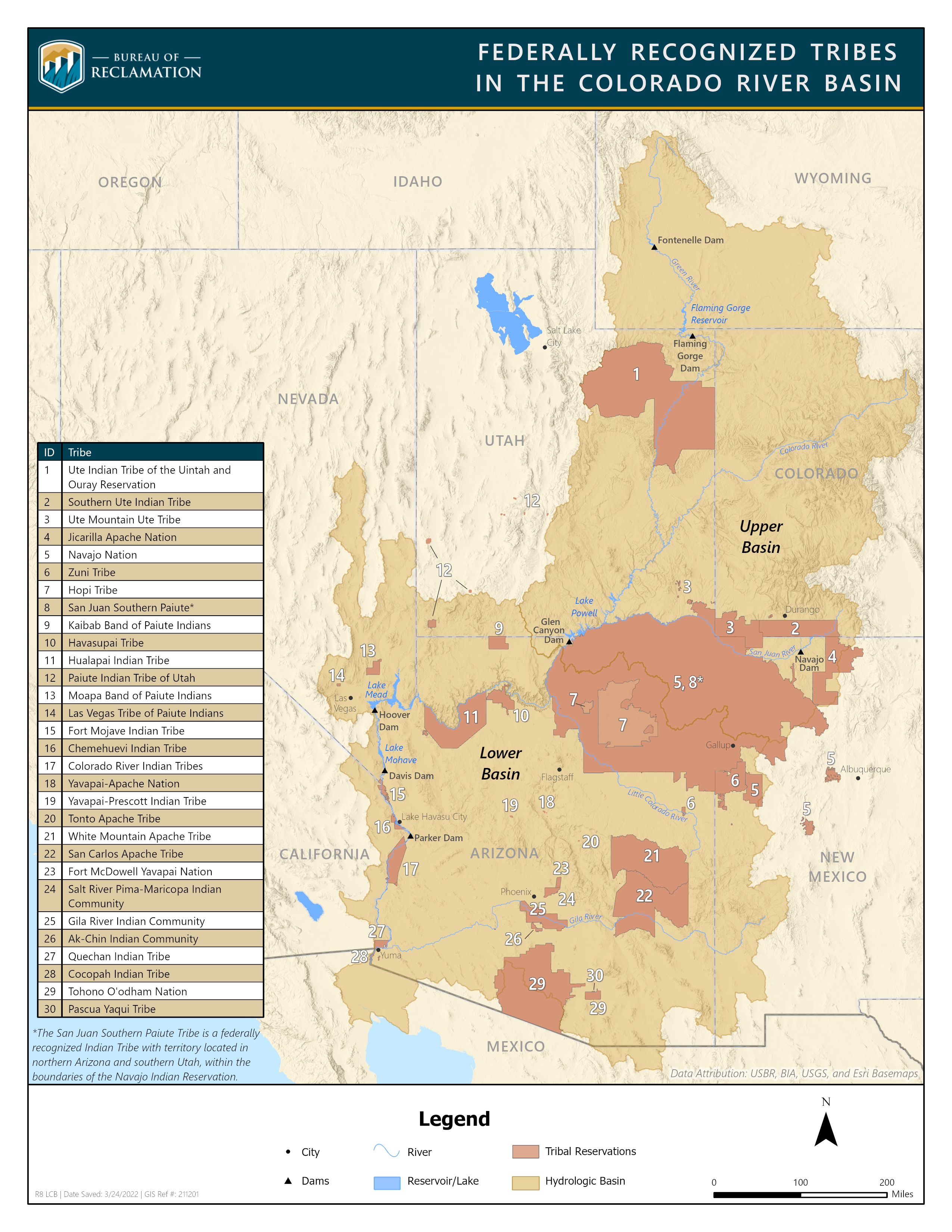- Reclamation
- Colorado River Basin

The Colorado River Basin, located in the southwestern United States, occupies an area of approximately 250,000 square miles. The Colorado River is approximately 1,400 miles long and originates along the Continental Divide in Rocky Mountain National Park, Colorado, and ends where it meets the Gulf of California in Mexico. The Colorado River is a critical resource in the West, because seven basin states (Arizona, California, Colorado, Nevada, New Mexico, Utah and Wyoming) depend on it for water supply, hydropower production, recreation, fish and wildlife habitat, and other benefits. Although agricultural uses depend on 70 percent of Colorado River water, between 35 and 40 million people rely on the same water for some, if not all, of their municipal needs. Moreover, the United States also has a delivery obligation to Mexico for some of the Colorado River waters pursuant to a 1944 Treaty with Mexico.
Featured Areas
Post 2026 Colorado River Operations
Supplemental EIS for Near-term Colorado River Operations
Drought Response Operations Agreement
Lower Colorado River Basin System Conservation and Efficiency Program
Upper Colorado River Basin System Conservation and Efficiency Program
Operating under the 2007 Interim Guidelines
Review of the 2007 Interim Guidelines & 7.D. Report
Announcements
-
Colorado River
Biden-Harris Administration Marks Major Progress for Colorado River System Health, Signs Five New Water Conservation Agreements
 Sept. 25, 2024 – The Department of the Interior today marked major progress for the short and long-term health of the Colorado River System. In Santa Fe, New Mexico, Bureau of Reclamation Commissioner Camille Calimlim Touton joined leaders from the Imperial Irrigation District (California), Bard Water District (California), Metropolitan Water District (California) and Gila River Indian Community (Arizona) to sign five water conservation agreements that will leverage funding from President Biden’s Investing in America agenda to help advance water conservation across the West. Read More →
Sept. 25, 2024 – The Department of the Interior today marked major progress for the short and long-term health of the Colorado River System. In Santa Fe, New Mexico, Bureau of Reclamation Commissioner Camille Calimlim Touton joined leaders from the Imperial Irrigation District (California), Bard Water District (California), Metropolitan Water District (California) and Gila River Indian Community (Arizona) to sign five water conservation agreements that will leverage funding from President Biden’s Investing in America agenda to help advance water conservation across the West. Read More → -
Operations
Reclamation announces 2025 operating conditions for Lake Powell and Lake Mead
Aug. 15, 2024 – The Bureau of Reclamation today released the Colorado River Basin August 2024 24-Month Study, which determines the operating tiers for the coordinated operation of Lake Powell and Lake Mead for 2025. Based on projections in the study, Lake Powell will operate in a Mid-Elevation Release Tier in water year 2025 and Lake Mead will operate in a Level 1 Shortage Condition with required shortages by Arizona and Nevada, coupled with Lower Basin Drought Contingency Plan water savings contributions, in calendar year 2025. Mexico’s water delivery, which includes reductions and water savings, is consistent with Minutes 323 and 330. Read More →
-
Colorado River
Reclamation begins cold water flows to disrupt spawning of nonnative fish below Glen Canyon Dam
 July 5, 2024 – As a result of warmer river temperatures, the Bureau of Reclamation will begin releasing deeper, and therefore, colder water on Tuesday, July 9 from Lake Powell through Glen Canyon Dam to disrupt the establishment of smallmouth bass, which could negatively affect populations of threatened humpback chub below the dam. The need for these flows was triggered after the average observed daily water temperatures reached smallmouth bass reproduction thresholds above 15.5 degrees Celsius (60 degrees Fahrenheit) at the confluence of the Colorado River with the Little Colorado River. Read More →
July 5, 2024 – As a result of warmer river temperatures, the Bureau of Reclamation will begin releasing deeper, and therefore, colder water on Tuesday, July 9 from Lake Powell through Glen Canyon Dam to disrupt the establishment of smallmouth bass, which could negatively affect populations of threatened humpback chub below the dam. The need for these flows was triggered after the average observed daily water temperatures reached smallmouth bass reproduction thresholds above 15.5 degrees Celsius (60 degrees Fahrenheit) at the confluence of the Colorado River with the Little Colorado River. Read More → -
Colorado River
Reclamation finalizes environmental process to combat nonnative fish below Glen Canyon Dam
 July 3, 2024 – The Bureau of Reclamation today finalized its process to protect the humpback chub and other federally protected fish species with the signing of the Supplemental Environmental Impact Statement for the 2016 Long-Term Experimental and Management Plan Final Environmental Impact Statement Record of Decision. Reclamation initiated the environmental review process in response to the increasing numbers of smallmouth bass in the Colorado River below Glen Canyon Dam. Read More →
July 3, 2024 – The Bureau of Reclamation today finalized its process to protect the humpback chub and other federally protected fish species with the signing of the Supplemental Environmental Impact Statement for the 2016 Long-Term Experimental and Management Plan Final Environmental Impact Statement Record of Decision. Reclamation initiated the environmental review process in response to the increasing numbers of smallmouth bass in the Colorado River below Glen Canyon Dam. Read More → -
Colorado River
Reclamation updates Colorado River consumptive uses and losses data
June 7, 2024 – The Bureau of Reclamation has updated its Colorado River System Consumptive Uses and Losses Report using recalculated data. The report presents recalculated estimates for calendar years 1971 to 2015 in the lower system and 1971 to 2023 in the upper system. Reclamation developed the updated data using consistent and current methodologies within each basin to improve the accuracy of the data across years and between reports. Read More →
-
Colorado River
Investing in America: Protecting the Colorado River
Flowing across 1,500 miles, two countries, 30 Tribal Nations and seven states, the Colorado River is more than a river—it’s the lifeblood of the West. Vital for supporting agricultural communities, businesses and cities, it also provides carbon-free, renewable hydropower while sustaining plant and animal life at every bend in the river. Bureau of Reclamation Commissioner Camille Calimlim Touton shares how we’re deploying $2.9 billion (to date) from the President’s #BipartisanInfrastructureLaw and #InflationReductionAct to fund 400 projects that will help conserve water, including the Colorado River Basin. We’re using this funding to evaluate projects that will build long-term system efficiency – like lining canals, restoring aquatic ecosystems, and increasing water efficiency.




